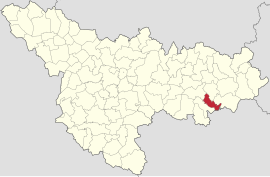| Criciova | |
|---|---|
| Commune | |
 Ruins of the Jdioara Fortress Ruins of the Jdioara Fortress | |
 Coat of arms Coat of arms | |
 Location in Timiș County Location in Timiș County | |
 | |
| Coordinates: 45°38′N 22°4′E / 45.633°N 22.067°E / 45.633; 22.067 | |
| Country | Romania |
| County | Timiș |
| Government | |
| • Mayor (2020–2024) | Romica Cătană (PSD) |
| Area | 50.51 km (19.50 sq mi) |
| Population | 1,493 |
| • Density | 30/km (77/sq mi) |
| Time zone | EET/EEST (UTC+2/+3) |
| Postal code | 307130–307133 |
| Vehicle reg. | TM |
| Website | www |
Criciova (Hungarian: Kricsó; German: Kritschau; Ukrainian: Кричова) is a commune in Timiș County, Romania. It is composed of four villages: Cireșu, Cireșu Mic (depopulated), Criciova (commune seat) and Jdioara.
History
Criciova was first mentioned in 1444 as Krychyowa, although it is much older. The fragments of masonry discovered here in the late 1970s attest that the village has existed since Roman Dacia.
The first recorded mention of Cireșu is found in a Hungarian diploma from 1603, in which it appears with the name Cziresul. Marsigli mentions in his notes from 1690–1700 the locality of Csíres or Cserestömös, in the Timiș River meadow. Around 1900, Ukrainians woodcutters began to settle on the hearth of the village, coming to work on the estates of Hungarian lords. In 1964, Cireșu incorporated the old village of Cireșu Nou, which had 129 inhabitants in 1966. Also, the hamlet of Cireșu Mic, once a colony of Ukrainian miners, belonged to Cireșu. It then became an independent village, but today it is completely depopulated.
The history of Jdioara is closely related to the homonymous medieval fortress, located about one kilometer northeast of the village, on one of the peaks that form the mountain ends towards the Timiș Valley, today only ruins. Several hypotheses have been issued about its establishment, among which the one circulated by Romanian historian Vasile Maniu [ro], who claimed that it was founded in the 2nd–3rd centuries, during the Roman colonization. Hungarian historians have claimed that the name of the fortress comes from the Hungarian Zydoy family, who allegedly built the fortress. It is certain that the first recorded mention of Jdioara dates from 1320, but most probably the fortress was built before this date. In the 10th–11th centuries, the fortress was probably included in Glad's voivodeship. The fortress has suffered two major sieges throughout its history. The first one took place in 1387, when the Banat nobles revolted against the central authority and occupied the fortress. The revolt was eventually suppressed, and the fortress came under the jurisdiction of the Ban of Severin, László Loszonczy, appointed commander of the fortresses of Severin, Orșova and Jdioara. The second major siege took place in May 1600 by the troops of Michael the Brave, for several days. Jdioara Fortress was destroyed after the Treaty of Karlowitz, probably subject to the conditions of the treaty which involved, among other things, the destruction of all the fortresses in Banat.
Demographics
Ethnic composition (2011)
Romanians (85.38%) Ukrainians (9.2%) Unknown (4.98%) Others (0.44%)Religious composition (2011)
Orthodox (79.9%) Baptists (7.56%) Pentecostals (5.17%) Unknown (6.43%) Others (0.94%)Criciova had a population of 1,587 inhabitants at the 2011 census, down 8% from the 2002 census. Most inhabitants are Romanians (85.38%), with a minority of Ukrainians (9.2%). For 4.98% of the population, ethnicity is unknown. By religion, most inhabitants are Orthodox (79.9%), but there are also minorities of Baptists (7.56%) and Pentecostals (5.17%). For 6.43% of the population, religious affiliation is unknown.
| Census | Ethnic composition | ||||
|---|---|---|---|---|---|
| Year | Population | Romanians | Hungarians | Germans | Ukrainians |
| 1880 | 2,464 | 2,323 | 32 | 89 | – |
| 1890 | 2,772 | 2,381 | 50 | 39 | 1 |
| 1900 | 2,918 | 2,608 | 65 | 139 | – |
| 1910 | 3,318 | 2,659 | 29 | 33 | 229 |
| 1920 | 3,247 | 2,812 | 10 | 9 | – |
| 1930 | 3,504 | 2,389 | 5 | 11 | 605 |
| 1941 | 3,181 | 2,309 | 14 | 9 | – |
| 1956 | 2,652 | 2,161 | 10 | 7 | 467 |
| 1966 | 2,509 | 2,067 | 11 | 5 | 426 |
| 1977 | 2,310 | 1,905 | 6 | – | 359 |
| 1992 | 1,774 | 1,474 | 8 | 1 | 288 |
| 2002 | 1,716 | 1,472 | 6 | 1 | 218 |
| 2011 | 1,587 | 1,355 | – | – | 146 |
References
- "Results of the 2020 local elections". Central Electoral Bureau. Retrieved 16 June 2021.
- "Primăria Criciova". Ghidul Primăriilor.
- "Populaţia rezidentă după grupa de vârstă, pe județe și municipii, orașe, comune, la 1 decembrie 2021" (XLS). National Institute of Statistics.
- ^ Szabó, M. Attila (2003). Erdély, Bánság és Partium történeti és közigazgatási helységnévtára. Miercurea Ciuc: Pro-Print Kiadó.
- Benea, Doina (2014). "Cercetările arheologice de la Criciova, punctul Tramnic (jud. Timiș) (1979–1980)" (PDF). Banatica. 24 (1): 305–310.
- "Trei localități „fantomă" din Timiș încă mai apar în acte deși nu mai au niciun locuitor". Opinia Timișoarei. 25 February 2015.
- ^ Lotreanu, Ioan (1935). Monografia Banatului. Timișoara: Institutul de Arte Grafice „Țara”. p. 226.
- ^ Bejan, Adrian (1980). "Cetatea feudală Jdioara". Materiale și cercetări arheologice (14): 514–523.
- ^ "Tab8. Populația stabilă după etnie – județe, municipii, orașe, comune". Institutul Național de Statistică. Archived from the original on 2016-01-18. Retrieved 2021-09-25.
- ^ "Tab13. Populația stabilă după religie – județe, municipii, orașe, comune". Institutul Național de Statistică. Archived from the original on 2020-08-07. Retrieved 2021-09-25.
- Varga, E. Árpád. "Temes megye településeinek etnikai (anyanyelvi/nemzetiségi) adatai 1880-2002" (PDF). Archived from the original (PDF) on 2007-06-10. Retrieved 2021-09-25.
